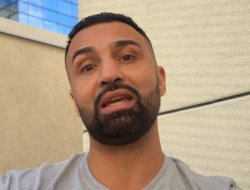American analyst, boxing commentator, and former two-category champion Paul Malignaggi burst into an interesting monologue in broadcast your video blog.
An expert with Italian roots singled out Eastern European boxing as a separate style that influenced people’s misjudgment of the new and old schools of professional boxing. Malignaggi singled out the Ukrainian ex-champion in three categories Vasily Lomachenko (16-2, 10 KOs) as a bright representative of a mixture of boxing cultures. The analyst also spoke about successful Soviet fighters and fighters from the former USSR who never became famous for their performances in the pros.
“The world is becoming more globalized and people are tying everything together. Things are getting more and more transformed. Even in boxing. There is less and less specific culture in different parts of the world. I mean, it happens even in boxing.”
“There was a distinct Western style of boxing, especially in North America. And there was a European style. Now there is an Eastern European style. More movement of the upper body – this came from North America. Heavy attacks to the body – from South and Central America. “a boxing style that was more technical but with less hip and upper body movement and more focus on the legs. And an Eastern European style that was harder, with little head movement, good fundamentals and a heavy punch.”
“I think it’s a mix of styles right now. We’re seeing Lomachenko, a fighter from Eastern Europe, who has a very flexible style, with American influences, sort of a hybrid style. He obviously excels in the fundamentals and is a great fighter. In my opinion, if you can put all the styles together in the right way, you will make such a great fighter like Lomachenko.”
“When you think of the Eastern European stereotype, you think of Ivan Drago from the movie Rocky — the guy who hits hard, the tenacious impersonal fighter who has a kind of ice in his veins. And when you look at Lomachenko and Usyk, they are always joking they have a hybrid boxing style and all of a sudden you realize hybrid personalities and boxing styles are kind of taking over more and more. “soldier, and no matter what people did in real life. Sports were no exception. Very, very regimen, very, very fixated on the basics. And they depended very heavily on success. No nonsense, and no matter what you do.” If the results are not successful, you will be quickly replaced or you will be quickly expelled.Because of this, success was very high compared to the West.Besides, this was the generation of the Cold War, they needed to compete with the West.They did not allowed to go professional because of the communist regime.”
“People who have had experience will agree with me that in amateurs it’s hard to have an awkward style and be successful. It’s hard to have an unconventional style and be successful. In pros it’s possible because there are many rounds and you just slowly take apart a standard boxer with some awkward movements. or style. But in short fights, like amateurs, the fundamentals of boxing win. It is rare to find a non-standard fighter who wins a lot in amateurs. For this reason, the entire Eastern European style in general was based on the regimen and on strong basics of boxing. And many of they were good punchers.”
“I think since the 90s, when the Soviet regime fell, we started to see some guys turn pro. But their culture has not yet fully become western, because many of their guys still do not turn pro. If you think about it about who I remember was this fighter Gaidarbek Gaidarbekov, who won the gold medal of the Olympics and beat Gennady Golovkin. also did not turn pro. Even after the communist regime or the era, the culture has not yet gone, and the psychology has not completely changed. I believe that now, 30 years after the Soviet Union, more and more Eastern European fighters are turning into pros. I do not think that many remain amateur.I think the goal for all of them is to eventually go pro.But this hard style is still there but it is becoming more hybrid as we see in the fighters who come to America “.
“Looking back, they’ve always been successful. I always say this. People say old school boxing is better than new school, that those guys were better than today. The main reason I disagree with that is because… Not considering that people are always getting stronger in the basics, in power, faster than in the past.Besides, the reason why it’s harder to be successful in boxing today is because the iron curtain fell in 1990. Since that time, professional “boxers have to deal with Eastern European fighters. And that’s an extra race of people, an extra style, an extra influx of high-level boxing that has joined the fray. So to become a champion, you have to go through those kinds of fighters as well.”
“Before 1990, to become a world-class professional, you had to beat the same ones, but the guys from Eastern Europe were not included here. You didn’t have to beat them. Once you turned pro, you didn’t have to fight them. Those guys who were successful in the pros, were knocked out in the amateurs by Cubans, Soviet fighters and the like. And we couldn’t see how these Eastern European fighters would progress over time.”
“People always say that the greatest amateur boxer was the Cuban Teofilo Stevenson. He won three gold medals, as did Felix Savon later. People always say that he was offered a lot of money to run away and fight Muhammad Ali. And he was too dedicated to his country. And so we were really robbed of a potential great fight. It never happened.”
“But Stevenson had his amateur rivals. I’ll tell you the name of the fighter who beat Stevenson twice and even knocked him out. This fighter was from the Soviet Union, his name was Igor Vysotsky. In 1973 he knocked out Teofilo Stevenson in their first meeting. Later he again defeated Stevenson in other competitions.The second time he didn’t knock him out, but there were several counts to 8.What a monster puncher he had to be to do this with the greatest fighter.Vysotsky’s problem was frequent cuts.He got cut before the Olympics and did not take part in the Olympic tournament in 1976. The Cubans had 2 heavyweights. If Vysotsky had participated, another would have boxed. And so the Cubans sent Stevenson, and he won the second of his three gold medals. Vysotsky no longer had a chance to fight him again. By 1980, Vysotsky was sort of worn out. He was beaten by another Russian fighter in qualifying for the Moscow Olympics. If I’m not mistaken, Stevenson took the third gold medal at that Olympics and beat that Russian fighter in the final. All things considered, this is pretty cool information. I may have missed some small details, but the point is that a lot of Eastern European fighters didn’t get recognition because they weren’t allowed to turn pro.”
“There is one more fact. Muhammad Ali did a world tour. He participated in exhibition fights around the world in these tours. That’s why he was the people’s champion. He came to the Soviet Union and had an exhibition fight with Vysotsky. And Ali after the exhibition fight said that was touched. It would be nice to see Vysotsky in that era. You can imagine if there was no communism, there would have been Ali and all these great heavyweights. It would have been the best heavyweight era in history, in my opinion. And if communism didn’t exist, we would have fighters like Teofilo Stevenson and Vysotsky in the pros. To me, the potential was incredible when we start this kind of discussion.”


